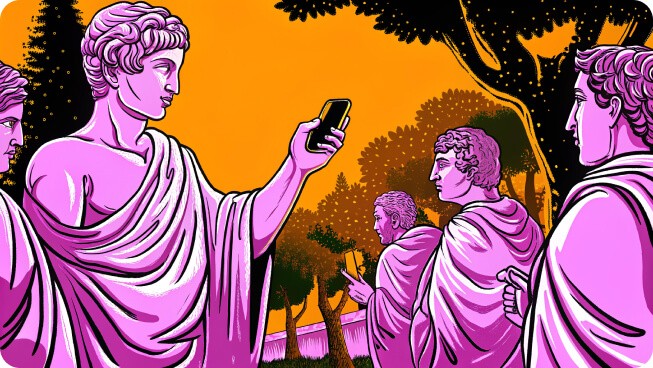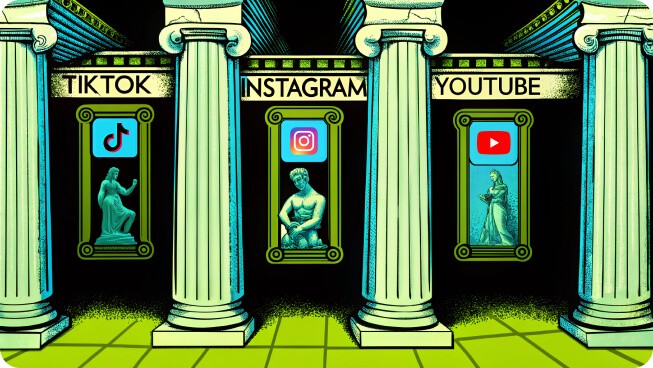Such short videos revolutionized the way people get information. What were once entertainment platforms, such as TikTok, Instagram Reels, and YouTube Shorts, have now become learning, promotion, and business resources. Whether you're a course provider, coach, or teacher, learning to operate on such platforms can help you reach zero to thousands (even millions) of targeted learners in zero to minimal time.
These platforms, such as Instagram, TikTok, and YouTube, feature bite-sized, visually dominant, and easily digestible pieces of content. A 15-second clip can create intrigue and lead the viewer to take an action. Short videos, well done, can bring you traffic to your course, boost sign-ups, and establish a legitimate online reputation associated with your personal or brand name.
Here, you'll learn exactly how to use TikTok, Instagram Reels, and YouTube Shorts to market your course in the best possible manner. From the best ways to get each of these apps to participate to video ideas to use, editing do's and don’t’s, and optimizing your strategy—our step-by-step game plan will teach you how to grow your course on bite-sized yet big-impact videos.
Understand the Platforms
To create videos, you first need to be familiar with how TikTok, Instagram Reels, and YouTube Shorts operate and how they differ.
TikTok
TikTok thrives on virality, on music, and on challenges. The algorithm has an amazingly ridiculous knack for putting your content in front of the perfect users—whether you've got a zero-fan account. Edutainment fares incredibly well on the platform, as long as it is created in a high-energy, in-your-face, or humorous manner.
Instagram Reels
Reels are ideal for creators who already have an Instagram audience or want to establish one. Your Reels, aside from showing up in followers’ feed, will be displayed in the Explore feed—giving you audiences you might otherwise not have reached. You can even repost Reels as Stories, or pin them to your profile.
YouTube Shorts
YouTube Shorts is YouTube's response to TikTok. Shorts are well-suited to taking advantage of YouTube's vast search traffic and communities. Even if you already have long-form video content on your channel, Shorts are a great way of driving traffic to them—or to driving traffic to a course link in your channel description.
Know Your Audience
To create good short videos, you first have to understand who you're addressing. There's a perfect learner for every course—either beginners, professionals, students, or hobbyists.

To start, recognize:
-
Age group (Are they teens, university students, professionals?)
-
Pain points (What problems are they attempting to solve?)
-
Learning objectives (Do they desire a new skill, a certificate, or simply an in-depth examination of a subject?)
Once you understand what resonates with your target demographic, you can adjust what you share to their interests and preferences. Younger audiences, for instance, respond best to upbeat, funny videos with popular music. Professionals respond best to clean visuals and direct, to-the-point counsel.
Spend time scrolling through the hashtag-based platforms based on your niche (e.g., #LearnEnglish, #UXDesignTips, #FitnessCoach). Pay attention to what does well in terms of tone and format. Are they formal or informal style videos? Are they voice-over or on-camera videos?
The more you know about your audience, the better your videos will be.
Content Ideas That Work
You don't have to be a seasoned movie producer to create fantastic content. The majority of performing short videos are simple, functional, and genuine. Utilize these seven engaging content ideas to market your course:
1. Quick Tips
Provide one helpful tip concerning your subject. Such as, “A tip to enhance pronunciation in English” or “A fix to address slow-loading sites.”
2. “Did You Know?” Facts
Incite curiosity. Present surprising or lesser-known facts that are related to your subject. These can be employed well to attract people's attention.
3. Mini-Tutorials
Dive into a small idea or procedure of 15–60 seconds. Examples: “3 steps to tie a tie” or “Yoga beginner pose for backache.”
4. Behind the Scenes
Reveal your course creation process, how you teach, or a glimpse of your day. It builds trust and rapport on a human basis.
5. Student Testimonials
Short video testimonies of satisfied students or screenshots of recommendations create social proof and trust.
6. Course Sneak Peeks
Let students preview 10 seconds of your videos, slides, or course material.
7. Problem and Solution Structure
Describe a typical issue and provide a straightforward solution that your course can address.
Mix and match these ideas to keep your content fresh and engaging.
Scripting and Editing Tips
These short videos require short, snappy communication. You have mere seconds to grab a viewer's attention—so each image and word matters.

Keep it short and focused
One message, one video. A good rule of thumb in general: if you can't deliver the message in 60 seconds or less, split the message into several videos.
Start with a hook
The first 2–3 seconds are crucial. Start with a powerful hook such as:
-
"Scroll down if you wish to learn."
-
“Most people get this wrong…”
-
“Here’s one thing I wished I knew before…”
Use captions
Most people have something to say while watching. Add text so they can read along. It's simple with apps like CapCut, Canva, and InShot.
End with a strong CTA
Close your video with a short call to action, for example:
-
"Want more? Link in bio."
-
“Take my course to learn more.”
-
"Follow for daily tips!"
Keep edits clean and quick
Employ jump cuts, zooms, and effects just to sustain the energy, but judiciously. The content is the hero.
Through good editing and scripting, you can persuade a user within a 15-second video to click, follow, or subscribe.
Posting Strategy
Consistency and timing matter just as much as content. A decent posting schedule gets you noticed and builds up over time.
How often should you post?
Try posting 3–5 times a week on every platform. It keeps the fans engaged and provides the algorithm time to expose your content. Don't try to be perfect, be consistent. Showing up is what matters.
Best times to post
There is no single "ideal" time, but generally:
-
TikTok: 6–10 PM represents an ideal time of peak interaction.
-
Instagram Reels: Use 9 AM–12 PM or 6–8 PM.
-
YouTube Shorts: Publish during weekday lunchtimes (12 PM–2 PM).
Experiment with different times and find out when your audience is busiest. There are statistics on all the websites that can guide you.
Use relevant hashtags
3–5 hashtags should be used in every post. Blend popular hashtags (such as #LearnOnline) and specific ones (such as #UXCourseTips) to reach a broader and more targeted audience.
Write strong captions and titles
Use action verbs and curiosity to generate clicks. Examples:
-
“This one tip revolutionized the way I edit video.”
-
“Struggling with grammar? Try this trick.”
Create eye-catching thumbnails (for Shorts)
Your YouTube thumbnail can make or break. Ensure that you make it clear, bold, and relevant.
Drive Traffic to Your Course
Producing high-quality videos is step one. To encourage users to enroll in your course, you'll send users from your videos to your course page.
Make use of a bio link
All three sites enable you to add a clickable link to your profile. Leverage this real estate—link to your online course page, a landing page, or a link-in-bio site like Linktree or Beacons if you have several resources to offer.
Include persuasive calls to action (CTAs)
End videos with specific instructions. Examples:
-
“Click the link in my bio to begin learning today.”
-
“Preview for free—take a look!”
-
“Join 500+ students already in the course.”
Don't ask people to do something on their own. Instruct them to do it.
Offer a lead magnet or a freebie
Be sure to invite potential customers to opt-in to a free mini-guide, checklist, or video lesson. Once they opt in, follow up with them via email and provide the entire course.
Pin main content
TikTok and Instagram let you pin up to three videos on your profile. Use that spot for your best course-related videos, so new visitors can see all of them first.
Minor adjustments of this type can help one-time viewers become enthusiastic learners.
Track and Improve
To reach more and do more, you have to know what works and what doesn't.

Utilize platform analytics
They both offer standard analytics:
-
TikTok: Monitor views, likes, shares, and watch time within the Creator Tools area.
-
Instagram Reels: View reach, saves, interactions, and retention in Insights.
-
YouTube Shorts: For accessing impressions, click-through rate (CTR), and audience retention, you can utilize YouTube Studio.
Figure out what the patterns were. What were the highest-viewed videos? What videos were driving traffic to the bio link? That's what you want to create more of.
Test and validate
Experiment with:
-
Duration of videos (15, 30, 60 seconds)
-
Hooks and opening lines
-
Editing rates or visual aesthetics
-
Calls to action (CTAs)
Avoid guessing—let the information lead you to what you can do next.
Study your high performers
Select 3 of your best videos and inquire:
-
What's the topic?
-
How was the structure?
-
What sort of reaction or remarks did it elicit?
Small incremental changes guided by insight can add up to dramatic impact. Continue to experiment, learn, and continually improve.
Conclusion
A short video could be the best promotional tool you can employ today to market your course. TikTok, Instagram Reels, and YouTube Shorts give you access to huge audiences and innovative methods of touching students in a matter of seconds.
Keep it simple. Keep it valuable, consistent, and authentic. The more you mess around and measure and tweak along the way, you'll experience real growth—not just in views, but in enrollments as well.
Remember: if you go viral, that's not what you want—what you want is to be noticed by the right people. And short videos are best to get to that.




